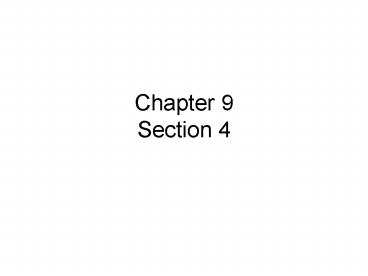Chapter 9 Section 4 PowerPoint PPT Presentation
1 / 17
Title: Chapter 9 Section 4
1
Chapter 9Section 4
2
No more economic controls
- After the war, the government removed economic
controls. - People raced to buy goods that had been rationed,
while businesses quickly raised prices that were
kept low during the war. - The result was inflation, which raised the cost
of livingthe cost of food, clothing, shelter,
and other items people need to survive.
3
Unions
- Workers wanted higher wages to keep up with
inflation, but business owners wanted to hold
down wages instead. - When World war I ended, workers in unions were
larger and more organized than before, capable of
organizing a strike. - As a result, there were many strikes in 1919.
4
Strikes
- Shipyard workers in Seattle organized the first
big strike. - Soon it became a general strike, or a strike that
involves all workers in a location, not just
workers in one industry. - The Seattle strike paralyzed the city for five
days. - Although the striker made no gains, the general
strike worried many people because it was a
technique used by radicals in Europe.
5
Boston PD
- When 75 of the police officers in Boston went on
strike, riots broke out in the city. - The police commissioner fired the strikers and
hired a new police force.
6
Steel Workers
- A strike by workers at U.S. Steel was one of the
largest strikes. - The company hired replacement workers and the
strike failed.
7
Race Riots
- Many soldiers returned home looking for work.
- Many African Americans, during the Great
Migration, had moved to the North during the war
to take factory jobs. - In the summer of 1919, frustration and racism
erupted in violence as 25 race riots broken out
across the nation.
8
As a resultof the race riots
- As a result of the race riots, membership in
NAACP surged after the war, when many African
Americans decided to fight for their rights
politically.
9
Red Scare
- The strikes in 1919 led many people to believe
that Communists might seize power and start a
revolution in the United States. - Many Americans felt betrayed when Russia withdrew
from the war. - Since the late 1800s, many Americans blamed
immigrants for bringing Communist ideas into the
United States.
10
Soviet Union
- They also blamed immigrants for labor problems
and violence. When Communists took control of
Russia, Americans feared they would try to start
revolutions in other places. - Americans became especially fearful when the
Soviet Union formed the Communist International.
11
Communist International
- Communist International was an organization that
coordinated the activities of Communist parties
in other countries. - As strikes started across the United States in
1919, the fear of Americans that Communists, or
reds, would seize power led to a panic known as
the Red Scare.
12
June 1919 Bombing
- Several incidents contributed to the panic,
including one in June of 1919 when eight bombs in
eight cities exploded within minutes of one
another. - One of these bombs damaged the home of U.S.
Attorney General A. Mitchell Palmer. - Most people believed the bombings were the work
of radicals trying to destroy the American way of
life.
13
FBI J. Edgar
- Palmer set up a special division within the
Justice Department. - The General Intelligence Division was headed by
J. Edgar Hoover, and it later became the Federal
Bureau of Investigation (FBI).
14
Palmer Raids
- Although evidence pointed to no one group as the
bombers, Palmer organized raids on the
foreign-born and on radicals. - Palmer rounded up many immigrants and had them
deported, or expelled from the country. - The Palmer raids were carried out without concern
for peoples civil rights. - Homes were entered without search warrants.
- People were jailed indefinitely and not allowed
to talk to their attorneys.
15
Palmer Raids
- Palmer was first praised for his work.
- However, when he failed to find any real evidence
of a revolutionary conspiracy, his popularity
faded. - The Red Scare led to anti-immigrant feelings and
a call for Congress to limit immigration.
16
End to Unrest
- Economic Problems, labor unrest, racial tensions,
combined to create a general sense of
disappointment. - By 1920, most Americans wanted an end to the
unrest within the country.
17
Return to Normalcy
- In the 1920 election, the Democrats ran James M.
Cox for President and Franklin D. Roosevelt as
Vice-President. - They ran on the ideals of progressivism.
- The Republicans ran Warren G. Harding.
- He called for a return to normalcy.
- He wanted the United States to return to the
simpler days before the Progressive Era reforms. - Many voters agreed with Harding, and he won by a
landslide.

